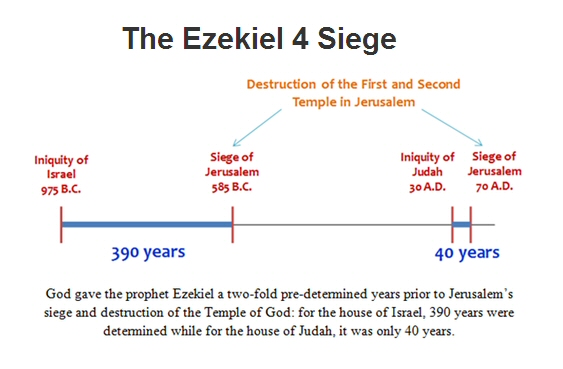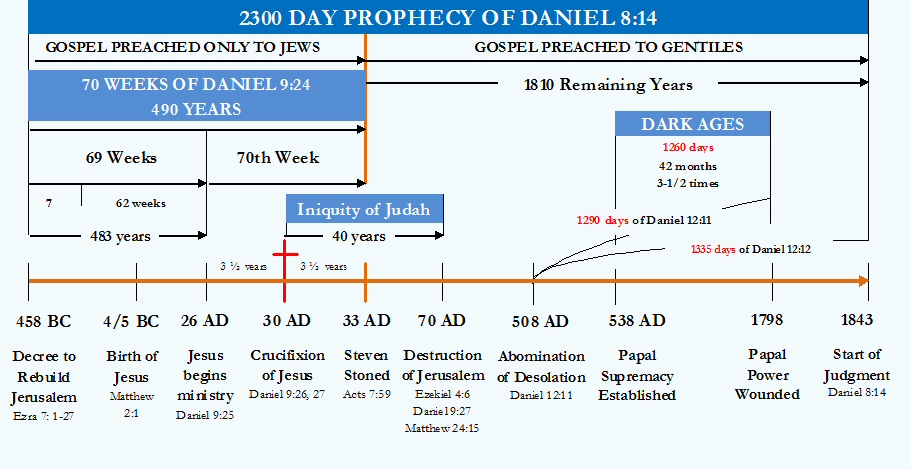Bible in Song
Sermons and
Commentaries
pages
have exposed flaws in the "2300 day" prophecy chart
most notably used by Seventh-day
Adventists.
Seventh-day Adventists in their biblical
interpretation have favored the
tradition of their founding fathers over Scripture and the
"divine revelation" of their own prophet Ellen White.
The "2300 day"
day prophecy of
Daniel 8
includes several shorter time prophecies which should
fit in and reconcile with the larger time period
parameters. The prophetic events of the chart should
also be consistent with known historical events and
other Scripture. Whilst the "2300 day" chart used by
Seventh-day Adventists accommodates the "1260 day"
prophecy from 538 to 1798, it does not reconcile with
the other shorter prophetic time periods including
the "70 weeks" of
Daniel 9, the "1290 days" of
Daniel 12 and "1335 days" also of
Daniel 12.
The "1290 day" and
"1335 day" time prophecies of
Daniel 12 and how they fit within the "2300 day"
time prophecy are well explained in our
Sermons and
Commentaries
pages, particularly in a
Sermon on Daniel 12.
Let's briefly have a look at another short prophecy
which is part of the longer "2300 day" prophecy. The "70 week" prophecy of
Daniel 9
began with the decree of
Artaxerxes 1. This prophecy predicted not only the
coming of the Messiah at the end of "69 weeks"
but that He would be
"cut off" or crucified in the midst of the 70th week. The decree of Artaxerxes
to rebuild Jerusalem is found in Ezra 7:11-28 and
comes in the seventh year of Artaxerxes (Ezra 7:8).
By counting 7 years from the beginning of Artaxerxes'
reign in 465 BC we know that the decree came in 458
BC. Although most biblical scholars agree on the year
458 BC there is no universal
agreement so it is beneficial to examine other evidence.
Scripture tells us
that Jesus died on Friday Nisan 14, the day prior to
the annual Passover, during the years AD 26-36 during
which Pilate governed. Astronomical records tell us
that a Friday crucifixion could only have occurred in
the years 27 AD, 30 AD and 33 AD. The year 27 AD is
generally accepted as too early. According to Wikipedia
the majority of modern scholars favour the year 30
AD, whilst the year 33 AD is also popular. The year
30 AD is generally favoured over 33 AD because it accommodates
the death of King Herod in 4 BC.
 There is also
support for a 30 AD crucifixion from the Jewish
Talmud and other Scripture passages including
Matthew 23:33-36,
Matthew 24:2,34,
Acts 1:3
and
Ezekiel 4:6. In Matthew 23 and 24 Jesus
predicted the destruction of the Temple and Jerusalem
which came to pass 40 years after His death and
resurrection.
Ezekiel 4 predicted the Roman army siege of
Jerusalem (which started at Passover in 70AD) and was
followed by the complete destruction of the city and
slaughter of up one million of its inhabitants. The
two million Jews who survived this calamity were then
sold into slavery or exiled from their own land and
scattered abroad to all the nations.
There is also
support for a 30 AD crucifixion from the Jewish
Talmud and other Scripture passages including
Matthew 23:33-36,
Matthew 24:2,34,
Acts 1:3
and
Ezekiel 4:6. In Matthew 23 and 24 Jesus
predicted the destruction of the Temple and Jerusalem
which came to pass 40 years after His death and
resurrection.
Ezekiel 4 predicted the Roman army siege of
Jerusalem (which started at Passover in 70AD) and was
followed by the complete destruction of the city and
slaughter of up one million of its inhabitants. The
two million Jews who survived this calamity were then
sold into slavery or exiled from their own land and
scattered abroad to all the nations.
All these texts prophesied that
the destruction of Jerusalem (70 AD) would occur 40
years after the iniquity of Judah (murder of the
Messiah).
Now only the Seventh-day
Adventists and Worldwide Church of God believe in a
31 AD crucifixion. According to astronomical records
Nisan 14 in 31 AD occurred on a Wednesday. The
Worldwide Church of God tries to get around this by
claiming that Christ laid in the tomb for 3 complete
24 hour days before a Sunday resurrection. The
Seventh-day Adventists have a lot of difficulty
trying to explain a 31 AD crucifixion and end up
relying upon comments made by their prophet Ellen White in
her book
'Desire of Ages' (DOA), which conformed to her
church's teachings/ traditions on the subject.
Let's have a quick look at the SDA modern prophet Ellen White
and how the church developed its "2300 day" prophecy
time chart.
In its early years the Seventh-day Adventist
church believed in an 1843 prophetic chart which was
recognized and attested by their prophet Ellen G. White in 1850 in
the Present Truth. In her book Early Writings
pgs. 74, 75 she wrote
"I have seen that the 1843 chart was directed by the
hand of the Lord, and that it should not be altered...".
Note that these comments were claimed to have been
made under "divine inspiration". However after the 1843 disappointment, SDA
pioneers
reset the date to 1844. The consequence of this was
that prophetic events had to be put forward by 1
year, even contrary to historical events.

Initially SDA pioneers tried to fudge some figures to
accommodate the "1290 day" and "1335 day" time
prophecies of
Daniel 12.
The fudging of those years was noted but not
explained. Then later they totally eliminated the
1335-day and the 1290-day periods from the chart.
They simply did not understand what they meant.
It has been noted that some pastors and scholars in the SDA
church have also questioned aspects of their church's
1844 chart, but in the end have reasoned, why it must
be right because Ellen White said so in her later
writings.
So we see
from the above that SDAs in their
interpretation of the "2300 day
prophecy" have placed higher
credence on Mrs White's writings
than overwhelming Scripture,
astronomical and historical
evidence. Why? The reason is that
they believe her writings are both
inspired and authoritative. But is
this belief well founded?
In her
books 'Great Controversy' (GC) and
DOA Mrs White commented that Jesus
died in 31 AD and that the 2300
day prophecy ended in 1844. Such
comments are inconsistent with her
"inspired" comments about the 1843
chart in her book 'Early Writings'
(EW). So which comments are we to
believe? The simple answer is that
not all Mrs White's comments were
inspired. Some of her writings
were sourced from other authors,
which clearly were not inspired.
Also Mrs White herself repeatedly
rejected suggestions that her
writings were on the same
inspirational level as the Bible.
Therefore to treat all her
writings as gospel would be to
reject Mrs White. The key is to
look at the context of her
writings.
A review
of Mrs White's comments re the
1843 chart in EW reveal that they
focussed on this specific
prophetic event and were
associated with claims of having
been received by vision or divine
revelation. This differs from her
later comments in GC and DOA
(written 50 years later), which
are included as asides to a
narrative/commentary on other
topics such as the life of Christ
and which were not associated with
similar claims of divine
inspiration. These comments were
sourced from and/or conformed to
the teachings/traditions of her
church on this subject. Therefore
they should not be held as being
inspired or authoritative.
The
problem with the SDA church today
is twofold. First, it regards Mrs
White's writings as inspired and
authoritative, which is to reject
her for what she claimed to be.
Secondly, the church favours the
teachings/tradition of its
founding fathers above both
Scripture and the "divine
revelation" of Mrs White.